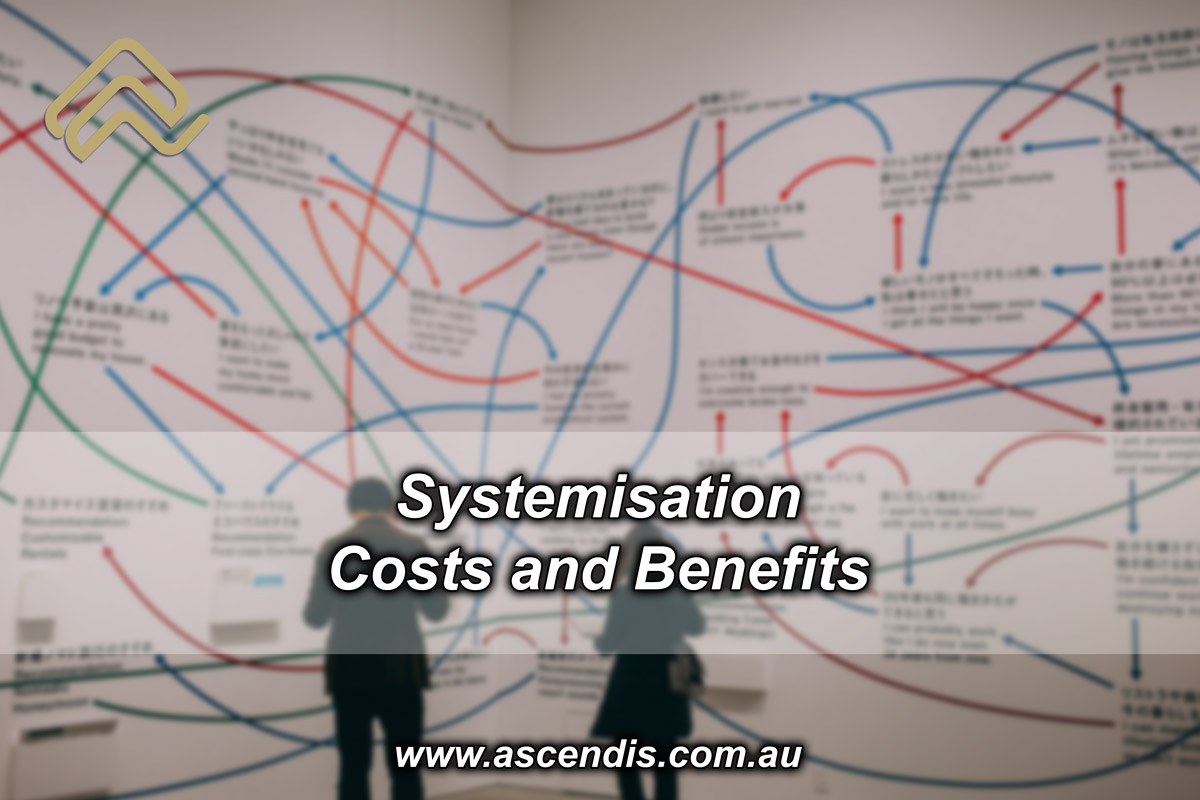Systemisation: Costs and Benefits

Knowledge and Experience. It is Available
22 January 2020
Have an Accountant yet You Still Don’t Know?
12 February 2020
Many businesses have systems and processes that aren't documented, are just habits formed within the business, or even made up as work is performed. It's a shortcut taken when businesses start up and when key players find themselves too busy to refine and document processes.
At What Cost?
The cost is more than just the expense of documentation and refinement, of getting and implementing software. It's the loss of not having clear, efficient and effective systems in operation. The process of systemisation should start with the current workflow and where improvements and simplifications can be made. And where competitive advantages can be gained.
If you are:
- doubling up on entries;
- have staff waiting on others or information;
- limitations on software or file accessibility;
- risk exposure (human errors or system);
- checking more work or entries than feel should be necessary;
- taking too long to complete tasks or deliver a product or service; or
- delivering inconsistently or at poor standards
... then your costs also lay in these areas, and continue to be a drain on your business until they're resolved.
Not Having the Benefits is Your Cost
Let's take a look at this in a measurable way, based on what I've seen from a client though I've seen this many times now. We'll also include a simple value chain analysis along the way.
When field staff fill in forms in the field, job forms or customer invoices these are then reentered by administrative staff. That might be 4 or more hours every single week, an annual cost of over $7,500. It also adds no real value to the product or service.
If that process is preceeded by a similar quotation process, where a customer is visited and a job reviewed, data recorded then taken back to the office and entered again in a spreadsheet to get the figures, then a Word document to get the quote back to the client. This would add some $40 to every single job, a cost that could be over $25,000 each year. There's also lost value to the customer as they wait for the quote to be provided.
Job management is another area that can need looking into. When staff doing the job are left waiting to know the schedule. Admin staff are juggling schedules, figuring out who should do which job and when. Sometimes jobs or key parts of jobs fall through the cracks. Wasted time and effort for the admin and front-line staff may see $15,000 lost in a year, whilst delivered a less than desirable service to customers.
Inventory management is another area, where customer orders are delayed due to poor planning and lack of adequate processes. Unexpected delays happen with no good reason. Customers are let down at the last minute. This one even happens in massive stores, recently for myself with a purchase at Myer where stock appeared in the systems to be in some stores but there actually wasn't any. From client experience I've seen this mean some $20,000 in wasted time and lost sales over the year with a trail of unhappy customers, or non-customers.
The Cost is Hidden
Nearly $70,000 being thrown away in this example, a real client we've had in the past, this forms a part of the cost of not properly systemising the business. One big problem is these costs are hidden. They are real and incurred but few actually look at how staff time is spent and what parts are wasted, are redundant.
So when looking at solutions, be it off-the-shelve software or custom built, the cost and implementation should be weighed against the cost of not doing it. Also include the value that's lost by not giving your customers a faster, a smoother, a more consistent, and a better informed service.
There are multi-million dollar companies that work like this and continue to do so. Hard to believe but even the big guys make the same mistakes as smaller businesses, the same problems but on a bigger scale.
When you feel you're incurring costs shown in the list above, take a moment to do a quick calculation of these and ask yourself... is it time we sort our systems?




